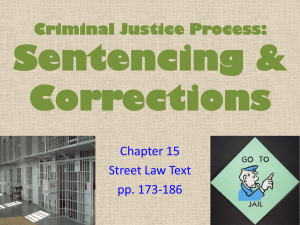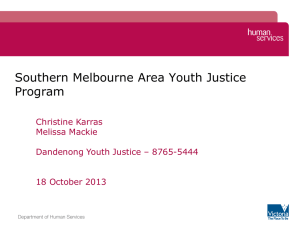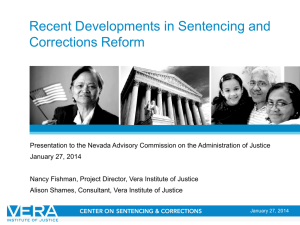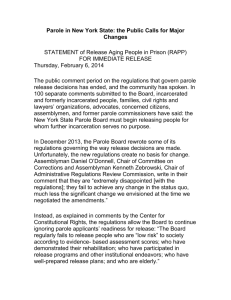For Immediate Release: How to safely reduce prison populations
advertisement
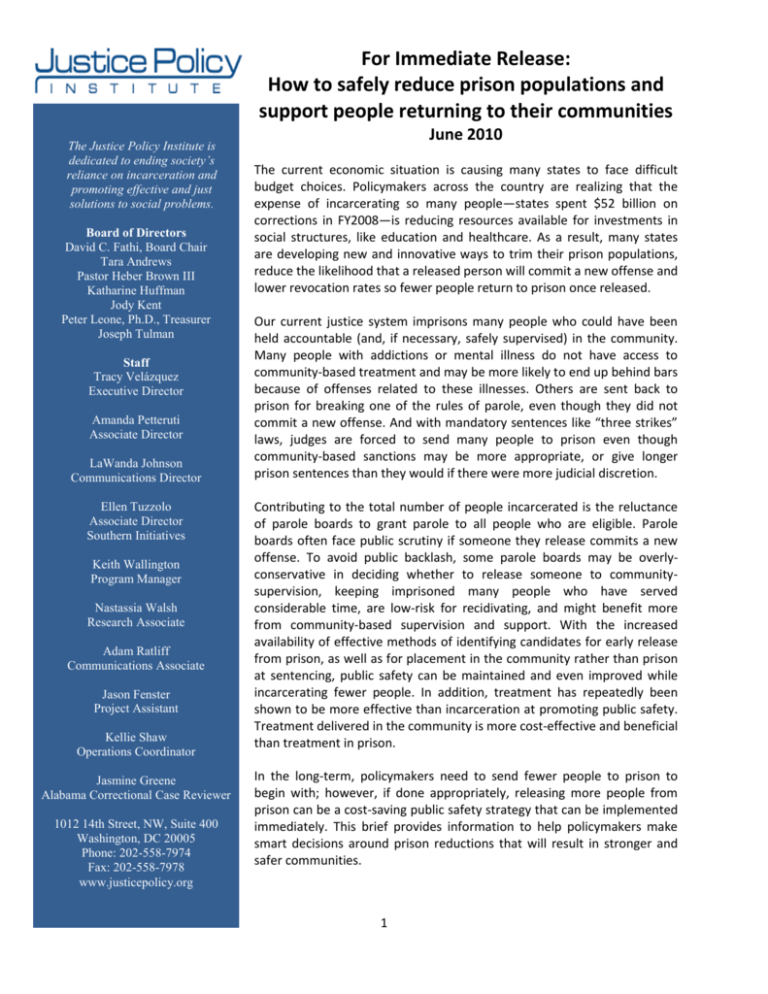
For Immediate Release: How to safely reduce prison populations and support people returning to their communities The Justice Policy Institute is dedicated to ending society’s reliance on incarceration and promoting effective and just solutions to social problems. Board of Directors David C. Fathi, Board Chair Tara Andrews Pastor Heber Brown III Katharine Huffman Jody Kent Peter Leone, Ph.D., Treasurer Joseph Tulman Staff Tracy Velázquez Executive Director Amanda Petteruti Associate Director LaWanda Johnson Communications Director Ellen Tuzzolo Associate Director Southern Initiatives Keith Wallington Program Manager Nastassia Walsh Research Associate Adam Ratliff Communications Associate Jason Fenster Project Assistant Kellie Shaw Operations Coordinator Jasmine Greene Alabama Correctional Case Reviewer 1012 14th Street, NW, Suite 400 Washington, DC 20005 Phone: 202-558-7974 Fax: 202-558-7978 www.justicepolicy.org June 2010 The current economic situation is causing many states to face difficult budget choices. Policymakers across the country are realizing that the expense of incarcerating so many people—states spent $52 billion on corrections in FY2008—is reducing resources available for investments in social structures, like education and healthcare. As a result, many states are developing new and innovative ways to trim their prison populations, reduce the likelihood that a released person will commit a new offense and lower revocation rates so fewer people return to prison once released. Our current justice system imprisons many people who could have been held accountable (and, if necessary, safely supervised) in the community. Many people with addictions or mental illness do not have access to community-based treatment and may be more likely to end up behind bars because of offenses related to these illnesses. Others are sent back to prison for breaking one of the rules of parole, even though they did not commit a new offense. And with mandatory sentences like “three strikes” laws, judges are forced to send many people to prison even though community-based sanctions may be more appropriate, or give longer prison sentences than they would if there were more judicial discretion. Contributing to the total number of people incarcerated is the reluctance of parole boards to grant parole to all people who are eligible. Parole boards often face public scrutiny if someone they release commits a new offense. To avoid public backlash, some parole boards may be overlyconservative in deciding whether to release someone to communitysupervision, keeping imprisoned many people who have served considerable time, are low-risk for recidivating, and might benefit more from community-based supervision and support. With the increased availability of effective methods of identifying candidates for early release from prison, as well as for placement in the community rather than prison at sentencing, public safety can be maintained and even improved while incarcerating fewer people. In addition, treatment has repeatedly been shown to be more effective than incarceration at promoting public safety. Treatment delivered in the community is more cost-effective and beneficial than treatment in prison. In the long-term, policymakers need to send fewer people to prison to begin with; however, if done appropriately, releasing more people from prison can be a cost-saving public safety strategy that can be implemented immediately. This brief provides information to help policymakers make smart decisions around prison reductions that will result in stronger and safer communities. 1 Prisons do not improve public safety. “There is a better way. We need to move from anger-based sentencing that ignores cost and effectiveness to evidence-based sentencing that focuses on results—sentencing that assesses each offender’s risk and then fits that offender with the cheapest and most effective rehabilitation that he or she needs. We know how to do this. States across the nation are moving in this direction because they cannot afford such a great waste of resources.”Chief Justice William Ray Price, Jr., Missouri State of the Judiciary Address1 The United States currently has the highest rate of incarceration in the world, holding 5 percent of the world’s overall population and 25 percent of its prison population. Despite “tough on crime” rhetoric that frequently calls for putting more people in prison, such practices are ineffective as a public safety strategy. Serving time in prison has been shown to increase the risk of future offending, not decrease it.2 Additionally, the trend of increasing prison sentences does not improve public safety. Data from the Department of Justice shows little difference in recidivism rates for people who spend short sentences in prison compared to those who are in prison longer.3 70% 66.0% 64.8% 64.2% 65.4% 68.3% 62.6% 63.2% 54.2% 60% 50% 40% 30% 20% 10% 61 months or more 37-60 31-36 25-30 19-24 13-18 7-12 0% 6 months or less Percent of released prisoners rearrested within 3 years There is no clear correlation between length of prison stay and rates of recidivism 80% Time Served in Prison (months) Source: Patrick A. Langan and David J. Levin, Recidivism of Prisoners Released in 1994 (Washington, D.C.: Bureau of Justice Statistics, 2002) http://bjs.ojp.usdoj.gov/content/pub/pdf/rpr94.pdf Many states have lowered their incarceration rates and still experienced a drop in crime. Between 1998 and 2007, states that had the greatest increases in incarceration rates did not necessarily see a corresponding drop in crime rates.4 In some states, the opposite was true: they reduced their incarceration rates and their crime rates fell. 1 Kansas City Star, “Judge Price Delivers State of the Judiciary Address,” February 3, 2010. http://primebuzz.kcstar.com/?q=node/21240 2 Lynne Vieraitis and others, “The Criminogenic Effects of Imprisonment: Evidence from State Panel Data, 1974 – 2002,” Criminology & Public Policy 6, no. 3 (2007): 589-622. A number of other studies also found serving time in prison increases the risk of future offending. 3 Patrick A. Langan and David J. Levin, Recidivism of Prisoners Released in 1994 (Washington, D.C.: Bureau of Justice Statistics, 2002) http://bjs.ojp.usdoj.gov/content/pub/pdf/rpr94.pdf 4 Justice Policy Institute, Factsheet: Percent Change in Incarceration and Crime Rates, 1998-2007 (Washington, DC: 2008) www.justicepolicy.org/images/upload/07-02_FAC_StatebyStateIncarceration_AC-PS.pdf 2 Parole can be used to safely reduce prison populations. Expanding parole eligibility is an immediate change that could be made with positive results in terms of reduced spending and lower prison populations. If implemented effectively, this increase in parole eligibility can have positive effects on public safety as well. Most people on parole (over 90 percent) do not return to prison for a new conviction.5 Parole allows people to return to their communities to participate in employment, treatment, education, families and other systems of support. Furthermore, people on parole are able to contribute to the local economy through their employment, financial support for their families and patronizing local businesses. Utilize risk assessments. Given their mandate to protect public safety, parole boards and policymakers need to make informed decisions on how to expand the number of people released onto parole supervision. A growing number of states are beginning to use actuarial assessments of risks and needs in various parts of the criminal justice system. These assessments look at what factors are statistically related to whether a person is likely to engage in illegal behavior in the future. While assessments are most commonly used in determining placement while incarcerated and the level of supervision intensity on parole, assessments could be used to broaden eligibility for parole. Decision-makers – judges and parole boards – could use assessments with clear guidelines and metrics to substantiate releasing people who are deemed “low risk” earlier than they might have previously felt comfortable doing. Decisions based on evidence rather than subjectivity help people in prison avoid perpetual denial of timely parole. Selecting people for release based on these risk assessments can ensure that we are releasing people responsibly and to the benefit of public safety. Reduce administrative delays in parole. A number of states are facing backlogs in parole hearings and releases, resulting in people staying in prison longer than planned. Even people who have received parole hearings and were granted release on parole may still be in prison due to administrative delays in their release. Expanding parole hearings and reviewing cases when they are scheduled can ensure that people are released on time. Parole boards should work with administrators of the prison as well as the parole supervision agency so people can be released to supervision in a timely manner. Reducing the number of people in prison who should not be there will reduce crowding and associated costs. One year of incarceration costs on average $23,8766 compared to one year of parole at $4,000 per year.7 Increase access to in-prison programming. Many states have restrictions on in-prison program participation (like rehabilitative programs or treatment) for people convicted of certain offenses or with particular classifications, and some are reducing programming as a cost-saving measure.8 As parole boards frequently take into account 5 Lauren E. Glaze and Thomas P. Bonczar, Probation and Parole in the United States, 2008 (Washington, DC: Bureau of Justice Statistics, 2009). Table 5. http://bjs.ojp.usdoj.gov/content/pub/pdf/ppus08.pdf 6 Public Safety Performance Project, One in 100: Behind Bars in American 2008 (Washington, D.C.: Pew Center on the States, 2008) www.pewcenteronthestates.org/uploadedFiles/8015PCTS_Prison08_FINAL_2-1-1_FORWEB.pdf 7 Rough high estimate for the average a state would spend on parole by using California as the high limit. JPI has been unable to find a single national cost estimate for parole. The cost of parole also varies widely from state to state. California Department of Corrections and Rehabilitation, “Third Quarter 2008 Facts and Figures” www.cdcr.ca.gov/Divisions_Boards/Adult_Operations/Facts_and_Figures.html 8 John Gramlich, “For state prisons, cuts present new problems,” Stateline, May 19, 2010. www.stateline.org/live/printable/story?contentId=485663 3 program participation when reviewing parole eligibility, excluding people based on these criteria or because of program-rationing can negatively impact their likelihood of parole release. Restricting participation can result in people staying in prison longer and stifle attempts to improve outcomes of people who are incarcerated. Policymakers should eliminate or adjust restrictions on program admission to allow more people to participate, and resist pressure to cut programs in prisons. This will not only help people in prison with the rehabilitative process, but it will make them more likely to be released on parole when they are eligible. Establish medical parole. "We can't afford to squander taxpayer dollars the way we currently are. There's a better way to do business - 36 other states are doing (medical parole), Texas is leading the way.”California State Senator Mark Leno9 A growing concern for states is the medical costs associated with large prison populations, especially as the population ages.10 Medical parole is an option available in many states whereby someone who is deemed “low risk” due to a serious physical or mental health condition is released earlier than they otherwise might be eligible. In addition to it being more humane to release people whose serious healthcare needs would be better served in the community, states would save correctional dollars, and the person might become eligible for federal programs such as Social Security Disability Insurance, Veterans benefits, Medicaid or Medicare once released. An important consideration for medical parole must be whether the person will in fact be able to receive the medical care they need upon release. Consider parole for aging people in prison. Longer sentences, which are in part the result of mandatory minimums and the abolition of parole in some states, have created an aging prison population.11 Older people are sometimes more expensive to imprison, primarily due to medical costs; the National Center on Institutions and Alternatives estimated in 1998 that releasing people age 55 or above who are convicted of nonviolent offenses could save the U.S. $900 million during the first year alone.12 With more medical needs and higher rates of deteriorating health conditions, the annual cost of imprisoning aging people is over $70,000,13 compared to $23,876 for the average person in prison.14 Furthermore, people over age 65 spend twice as much time in medical facilities, but Social Security, Medicare, Veterans and Medicaid benefits do not apply to people in prisons, so states must pick up these medical costs.15 9 Talking about his bill, SB1399 that would allow inmates who do not pose a public safety threat and are incapacitated to be "medically" paroled. Marisa Lagos, “Small group of inmates costs states plenty,” The San Francisco Chronicle, May 19, 2010. www.sfgate.com/cgi-bin/article.cgi?file=/c/a/2010/05/19/MN7E1DGKPK.DTL 10 See Marisa Lagos, May 19, 2010. 11 Tina Chiu, It’s About Time: Aging Prisoners, Increasing Costs, and Geriatric Release (New York, NY: Vera Institute of Justice, 2010). www.vera.org/download?file=2973/Its-about-time-aging-prisoners-increasing-costs-and-geriatric-release.pdf 12 H.J. Hoelter and Barry Holman, Imprisoning Elderly Offenders: Public Safety or Maximum Security Nursing Homes (Washington, D.C.: National Center on Institutional Alternatives, 1998). Cited in Neil Duckett and others, Issues in Maryland Sentencing – The Aging Maryland Prison Population (College Park, MD: Maryland State Commission on Criminal Sentencing Policy, 2001). www.msccsp.org/publications/issues_aging.html 13 B. Jaye Anno and others, Correctional Health Care: Addressing the Needs of Elderly, Chronically Ill, and Terminally Ill Inmates (Washington, DC: National Institute of Corrections, 2004). 14 Public Safety Performance Project, 2008 15 J.B. Morton, An Administrative Overview of the Older Inmate (Washington, D.C.: National Institute of Corrections, 1992). Cited in Neil Duckett and others, 2001 4 Annual cost of imprisonment Aging people cost more than the average person to incarcerate $80,000 $70,000 $60,000 $50,000 $40,000 $30,000 $20,000 $10,000 $0 $70,000 $23,876 Aging person Average person Source: B. Jaye Anno and others, Correctional Health Care: Addressing the Needs of Elderly, Chronically Ill, and Terminally Ill Inmates (Washington, D.C.: National Institute of Corrections, 2004); Public Safety Performance Project, One in 100: Behind Bars in American 2008 (Washington, D.C.: Pew Center on the States, February 2008) www.pewcenteronthestates.org/uploadedFiles/8015PCTS_Prison08_FINAL_2-1-1_FORWEB.pdf As the prison population ages, government agencies should consider releasing more older people on parole because as people age they are less likely to engage in illegal behavior. People over age 45 are significantly less likely to participate in illegal activity and have lower re-arrest rates following release than younger people. A study by the U.S. Department of Justice found that, nationwide, only 17 percent of people over age 45 who were released from prison in 1994 were re-imprisoned with a new sentence within three years, compared to over 30 percent of people in their early 20s.16 Decision-makers and legislators should use this statistical risk information to reduce the number of older people behind bars. Instituting and making use of opportunities for geriatric release would yield significant savings without posing an increased threat to public safety. As people convicted during the recent boom in mandatory minimums and truth-in-sentencing laws grow older, costs of confinement will be an even greater burden, and avenues for community-based supervision and parole are a smart and safe means of saving money and reducing the number of people in prison. Expanding parole supervision to people from older age groups could save precious resources and allow people to spend their senior years with their families. Currently, only 15 states and the District of Columbia have provisions for release of older people from prison; however, these policies are severely under-utilized.17 Institute better “good time” policies. Good time credits can be earned through good behavior and through participation in or completion of classes and programs in the community on supervision or in prison. In some states these credits count toward the total sentence and not just the time spent in prison before parole. Allowing people on parole to accumulate “good time” credits while they are under community supervision, not just while they are incarcerated, would provide incentives for people on parole, and would reduce the amount of time that a person is under supervision. This would not only lower costs of supervision, it also decreases opportunities for a person to have their parole revoked due to a technical violation. Fewer parole revocations means fewer people returning to prison. 16 17 Patrick A. Langan and David J. Levin, 2002. Table 8. Tina Chiu, 2010 5 In addition to expanding good time credits to people on parole, states can expand the types and availability of these credits in correctional facilities, so that there are more opportunities for people in prison to return to the community sooner. Frequently, because of a variety of financial and administrative reasons, people in prison who are willing to participate in programs that earn them “good time” credits are unable because they are unavailable or full. For instance, if someone can receive credits for participating in anger management classes, but there is a waiting list for the class or the class isn’t being offered, this means he or she cannot earn these credits. Ensuring that people can access all available credits and opening up new opportunities for people to work toward receiving credits would be cost-effective for states seeking to reduce their prison population, and would provide people with skills and knowledge to reduce the chance that they recidivate after release. Implement or expand work release or community corrections. Most states and counties offer some form of work release or community corrections programs that allow people to serve their time while still maintaining ties to the community. Programs vary, but many require people to maintain employment and some require that people live in transitional housing or other facilities when not working. These programs allow people to stay in the community and begin to build positive social ties and contribute to the economy, instead of expending scarce public resources while incarcerated. Implementing evidence-based work release and community corrections programs can reduce the number of people in prison who can safely work in the community and promote employment and accountability. Improving parole supervision practices will reduce the number of people returned to prison. States vary in their parole supervision practices and policies. Some states have moved to a more serviceoriented approach that helps people succeed rather than relying on a strictly surveillance modality that waits for failure. A report by the Pew Center on the States found that parole guidelines present an onerous burden that can make successful transition to the community difficult.18 People with substance abuse problems may be unable to abstain from substance use—a common condition of supervision— without appropriate and available treatment and support. People who are unskilled or undereducated may be unable to find and maintain employment, generally a condition of supervision; this is particularly true in difficult economic times, as many employers are unwilling to hire people with felony convictions. This also makes it difficult to pay fines, fees, restitution and child support—all conditions of parole supervision. Finding and maintaining a place of residence (another condition) is especially challenging for people on parole, who are often locked out of publicly assisted housing because of their criminal record. Even a condition barring association with other people with convictions can be virtually impossible for a person on parole to comply with, especially when they came from and return to areas where many other people on parole live, such as densely populated cities. In order to effectively support people returning to the community after serving time in prison, parole agencies need to have adequate resources not only to supervise but more importantly, to provide assistance and support. Approximately 25 percent of people on parole in 2008 returned to prison for a 18 Peggy Burke, When Offenders Break the Rules: Smart Responses to Parole and Probation (Washington, D.C.: The Pew Center on the States, Public Safety Performance Project, 2007) www.pewtrusts.org/uploadedFiles/wwwpewtrustsorg/Reports/sentencing_and_corrections/Condition-Violators-Briefing.pdf 6 technical violation.19 By shifting the modality of supervision to one of support and service, states could send fewer people back to prison for technical violations or new offenses. Calibrate intensity of supervision to intensity of need. People who have been recently released from prison, people who may be at higher risk of recidivism and people who have greater needs may benefit from seeing a parole officer frequently and for significant amounts of time. Those who have been successfully meeting the requirements of supervision, are lower risk and have fewer needs can be seen less frequently or even put on administrative caseloads. Some states are also releasing people without parole supervision who are considered very low risk, but who for a number of different reasons, including mandatory sentences, received inappropriately long prison sentences. In this way, people who truly need the supervision and programs get them, and those who are doing well can re-enter and contribute to their communities. Researchers and experts in supervision best practices have developed an array of specific suggestions to increase the number of people on supervision and to also ensure that they transition successfully into the community and stay there. States like Texas and New Jersey have shifted supervision modalities from intense supervision to support and seen positive results; fewer people are returning to prison on technical violations, saving millions of dollars annually in incarceration costs. In addition, states are creating “half-way back” treatment facilities to intensively address the needs of people who are struggling on community supervision and instituting systems of graduated responses that incentivize positive achievements and provide more measured sanctions for setbacks. Implementing system innovations like these are shown to improve outcomes for people on community supervision. People need support after release to be successful in the community. “We are following a broken strategy of cramming inmates into prisons and not providing the type of drug treatment and job training that is necessary to break their cycle of crime. Any normal business would have abandoned this failed practice years ago, and it is costing us our shirts.”Chief Justice William Ray Price, Jr., Missouri State of the Judiciary Address20 Providing appropriate supports and services will help those who are released either with or without supervision to be successful and will protect public safety. Best practices in re-entry call for people to begin the re-entry process while still incarcerated and to continue after release. Institutional case managers should conduct a full assessment of risks and needs upon a person’s entry into prison, so that services and programming are tailored to each person throughout the time they are incarcerated; this case plan should be updated regularly and should extend to the time after they are released. As the person is approaching their release date, the case manager can provide a release plan with referrals to re-entry organizations outside of the prison and treatment programs if necessary. Increase access to treatment in the community. Substance-involved people have come to compose a large portion of the prison population. Substance use may play a role in the commission of certain crimes: approximately 16 percent of people in state prison and 18 percent of people in federal prison reported committing their crimes to obtain money for 19 20 Lauren E. Glaze and Thomas P. Bonczar, 2009. Table 5. Kansas City Star, February 3, 2010. 7 drugs.21 Treatment delivered in the community is one of the most cost-effective ways to prevent such crimes and costs approximately $20,000 less than incarceration per person per year.22 A study by the Washington State Institute for Public Policy found that every dollar spent on drug treatment in the community yields over $18 in cost savings related to crime.23 In comparison, prisons only yield $.37 in public safety benefit per dollar spent. Releasing people to supervision and making treatment accessible is an effective way of reducing problematic drug use, reducing crime associated with drug use and reducing the number of people in prison. Examine and reduce collateral consequences of conviction. We know what people need when they are returning to the community: jobs, housing, mental health or substance abuse treatment and other types of support. Currently, there are a number of state and federal laws that in one way or another prevent people from accessing these necessities, as well as benefits like student loans for higher education. Eliminating these barriers, through changes to state’s rules concerning Temporary Assistance to Needy Families (TANF) and food stamps for instance, could make it easier for people to receive a second chance at a successful and productive life. States are already using innovative methods to reduce their prison populations. “We can live in fear and make bad policy based on fear or we can have some backbone and make policy based on what really helps our communities.” Patricia L. Caruso, director of the Michigan Department of Corrections24 Many states have already started releasing people early from prison to community supervision. Others have also improved supervision to reduce the chances that someone will return to prison. Following examples from other states while figuring out the most effective ways to implement these policies and practices in individual states can lead to long term benefits in public safety, budgets and communities. TEXAS—In May 2007, Texas enacted various policies that saved the state $210.5 million over the 20082009 fiscal years. Those policies included 3,800 combined beds for residential and out-patient drug treatment for people on probation, maximum sentence lengths for people on probation, maximum case limits for parole officers, and incentives for counties that establish progressive sanctioning models for parole and probation systems.25 If new treatment and diversion programs are successful and no additional prisons are constructed, the state will save an additional $233 million. KANSAS—Under 2007 legislation, Kansas granted people in prison a 60-day credit for participating in certain programs designed to facilitate reintegration into the community. The state projects savings of approximately $80 million in the next five years. Prior to the legislation, Kansas had already changed the 21 Christopher Mumola and Jennifer C. Karberg, Drug Use and Dependence, State and Federal Prisoners, 2004 (Washington, D.C.: Bureau of Justice Statistics, 2006) http://bjs.ojp.usdoj.gov/content/pub/pdf/dudsfp04.pdf 22 For more information, please see the JPI report, Pruning Prisons: How Cutting Corrections Can Save Money and Protect Public Safety (Washington, D.C.: Justice Policy Institute, 2009) www.justicepolicy.org 23 Steve Aos and others, The Comparative Costs and Benefits of Programs to Reduce Crime (Olympia: Washington Sate Institute for Public Policy, 2001) www.wsipp.wa.gov 24 Monica Davey, “Safety is Issue as Budget Cuts Free Prisoners,” New York Times, March 4, 2010. 25 Justice Center, Justice Reinvestment State Brief: Texas (Bethesda, MD: Council of State Governments, 2007) www.pewcenteronthestates.org/uploadedFiles/TX%20State%20Brief.pdf 8 philosophy of parole by hiring social workers to be parole officers and asking parole officers to ensure that people on parole stay out of prison, rather than simply monitoring them to catch them if they violate the terms of probation.26 NEVADA—In 2007, Nevada passed a bill allowing people on probation to earn credits toward the reduction of their sentence. The legislation also establishes a series of graduated sanctions for violation of the terms of parole to prevent the immediate return to prison.27 NEW JERSEY—The Halfway Back Program in New Jersey works with people on parole who are at risk of returning to prison on technical violations by assisting them with job placement, family, vocational and educational training, anger management, and substance abuse treatment to keep them from returning to prison.28 Investments in this program, in combination with the addition of risk assessment centers, are estimated to save $14 million in FY2010.29 GEORGIA—As part of the National Institute of Correction’s Transition from Prison to the Community Initiative (TPCI), Georgia began implementing a data-driven, outcome-based approach to parole, with the goal of improving completion rates for people on parole.30 As part of the initiative, parole officers serve as advocates, providing access to treatment, training, and other services for people on parole. The TPCI also includes improved risk assessment instruments designed to improve the accuracy of predicting whether a person is at high risk of being reconvicted of a new crime.31 MICHIGAN—Great strides have been made in Michigan in recent years to reduce the prison population and reintegrate people into communities. Michigan’s parole rate is the highest it’s been in 16 years,32 and the state prison population has shrunk to from 51,500 in 2007 to 45,000 this year.33 Gov. Jennifer M. Granholm has approved 133 commutations, expanded the state’s parole board, and recently proposed a budget that presumes 7,500 fewer prisoners next year for savings of more than $130 million. The state has also expanded programs for people returning to their communities, direction millions of dollars toward helping them stay out of prison.34 Other states have identified mounting prison populations as a problem for taxpayers, and are exploring ways to relieve this burden. Colorado planned to release up to 6,400 people from prison in an effort to cut the state’s budget.35 Still, the state has not been able to release as many people as expected and is 26 Erik Eckholm, “New Tack on Straying Parolees Offers a Hand Instead of Cuffs,” New York Times, May 17, 2008. www.nytimes.com/2008/05/17/us/17parole.html 27 th 74 Regular Nevada Legislature, Assembly Bill No. 510—Select Committee on Corrections, Parole, and Probation (Carson City, NV: Nevada Legislature, 2007) www.leg.state.nv.us/74th/Bills/AB/AB510_EN.pdf 28 Michael Ostermann, “An Analysis of New Jersey’s Day Reporting Center and Halfway Back Programs: Embracing the Rehabilitative Ideal through Evidence Based Practices,” Journal of Offender Rehabilitation 48, No. 2 (2009): 139-153. 29 Testimony of Peter J. Barnes, Chairman, New Jersey State Parole Board, April 15, 2008, www.njleg.state.nj.us/legislativepub/budget%202009/Testimony/SPB_Barnes_testimony.pdf 30 Danny Hunter and others, “Improving Parole Outcomes with Performance Leadership and Data,” Topics in Community Corrections: Promising Strategies in Transition from Prison (Aurora, CO: National Institute of Corrections, 2007) http://nicic.org/Downloads/PDF/Library/022777.pdf 31 Georgia Board of Pardons and Paroles, Georgia Parole Decisions Guidelines (Atlanta, GA: 2007) www.pap.state.ga.us/opencms/export/sites/default/resources/Proposed_Parole_Decision_Guidelines.pdf 32 Monica Davey, March 4, 2010. 33 Mark Hornbeck, “Michigan Prisons Focus on Released Inmates,” Detroit News Lansing Bureau, April 7, 2010. 34 Monica Davey, March 4, 2010. 35 Kirk Mitchell, “Colo. Budget Plan: 6,400 Prisoners Face Early Release,” Denver Post, September 15, 2009. 9 continuing to work on a solution. Illinois released 1,700 people from prison over three months in 2009.36 Both Oregon37 and Tennessee38 are planning on releasing thousands of people from prison and use the money saved to reinvest in the best interests of residents. Conclusion: Making smarter investments in communities and social institutions is the most effective way of improving public safety and supporting communities. Shifting public dollars away from prisons and towards positive investments in people doesn’t involve a public safety “trade-off.” Research shows that states that spend more on education have lower crime rates than states that spend less. And more funding for housing also correlates with lower incarceration rates. Having a job has also been shown to be one of the largest predictors both staying out of prison and of success for people re-entering the community from prison.39 With the money saved on prisons, states can maintain or expand education, housing, employment training, and cost-effective services for both youth and adults. In this way, policymakers can maintain safe communities today, while building stronger communities for the future. 36 Monica Davey, March 4, 2010. Sherry Rainey, “To pay for prisons, Oregon might release some prisoners,” The Oregonian, June 8, 2009. 38 Chas Sisk, “Tennessee may release 4,000 prison inmates to cut costs,” The Tennessean, November 16, 2009. 39 See Justice Policy Institute, Employment, Wages and Public Safety (Washington, D.C.: 2007) www.justicepolicy.org/contenthmID=1811&smID=1581&ssmID=67.htm 37 10

